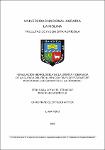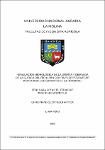Mostrar el registro sencillo del ítem
Simulación hidrológica de la oferta y demanda de la Cuenca del Río Lurín con fines de establecer indicadores de garantía de la demanda
| dc.contributor.advisor | Ramos Fernández, Lía | |
| dc.contributor.advisor | Paredes Arquiola, Javier | |
| dc.contributor.author | Olortegui Artica, Christiand | |
| dc.date.accessioned | 2021-02-03T23:07:46Z | |
| dc.date.available | 2021-02-03T23:07:46Z | |
| dc.date.issued | 2020 | |
| dc.identifier.uri | https://hdl.handle.net/20.500.12996/4598 | |
| dc.description | Universidad Nacional Agraria La Molina. Facultad de Ingeniería Agrícola. Departamento Académico de Recursos Hídricos | es_PE |
| dc.description.abstract | Más del 70 por ciento de la población en los distritos de San Damián y Santiago de Tuna, de la cuenca Lurín, está dedicada a la actividad agropecuaria y dependen del recurso hídrico; por tanto, la sostenibilidad de la actividad socioeconómica se ve afectada si no hay un manejo adecuado del agua. Una de las alternativas de solución es tomar decisiones informadas en base a indicadores de eficiencia para el manejo del recurso hídrico. En este sentido, se desarrolló la simulación hidrológica de la oferta y demanda, con las herramientas EvalHid, y el módulo de asignación del recurso hídrico SIMGES, de AQUATOOL para la obtención de indicadores de garantía en el abastecimiento de la demanda agraria en la cuenca Lurín. La calibración obtenida en la subcuenca San Damián e intercuenca Antapucro tuvo un rendimiento muy bueno y del análisis de los resultados se obtuvo un superávit anual de 40 hm3 , entre enero a marzo, y, déficit de 41 hm3 entre abril a diciembre, de un año medio. Luego de incorporar y simular el módulo de asignación del recurso, evaluado hasta el 2019, se determinó que los suministros de los trece subsectores hidráulicos de la cuenca media y baja de Lurín, presentan déficits anuales que varían de 1,0 a 10,2 hm3 ; y, no cumplen con los criterios de satisfacción para demandas agraria establecidas por el MINAGRI (2015). Además, en los subsectores hidráulicos con mayor déficit (S.H Lurín) y menor déficit (S.H Jatosica-Sotelo)se obtuvieron valores de garantía volumétrica de 53 y 75 por ciento; máximo déficit mensual de 2,5 y 0,49 hm3 y máximo déficit de dos meses seguidos de 4,0 y 0,8 hm3 , respectivamente. Lo que indica que se deben tomar medidas de gestión en relación al cumplimiento de los indicadores de garantía de la demanda agraria. | es_PE |
| dc.description.abstract | More than 70 percent of the population in the districts of San Damián and Santiago de Tuna, in the Lurín basin, is dedicated to farming and depends on water resources; therefore, the sustainability of socio-economic activity is affected if there is not adequate water management. One of the alternative solutions is to make informed decisions based on efficiency indicators for the management of water resources. In this sense, the hydrological simulation of supply and demand was developed, with the EvalHid tools, and the SIMGES water resource allocation module, from AQUATOOL to obtain guarantee indicators in the supply of agricultural demand in the Lurín basin. The calibration obtained in the San Damián sub-basin and the Antapucro inter-basin had a very good performance and the analysis of the results obtained an annual surplus of 40 hm3 , between January to March, and a deficit of 41 hm3 between April and December, of one year means, medium. After incorporating and simulating the resource allocation module, evaluated until 2019, it was determined that the supplies of the thirteen hydraulic subsectors of the middle and lower Lurín basin present annual deficits that vary from 1,0 to 10,2 hm3 ; and, they do not meet the satisfaction criteria for agrarian demands established by MINAGRI (2015). Furthermore, in the hydraulic subsectors with the highest deficit (S.H Lurín) and the lowest deficit (S.H Jatosica-Sotelo), volumetric guarantee values of 53 and 75 percent were obtained; maximum monthly deficit of 2,5 and 0,49 hm3 and maximum two-month deficit in a row of 4,0 and 0,8 hm3, respectively. This indicates that management measures should be taken in relation to the fulfillment of the indicators of guarantee of agricultural demand | en_US |
| dc.format | application/pdf | en_US |
| dc.language.iso | spa | es_PE |
| dc.publisher | Universidad Nacional Agraria La Molina | es_PE |
| dc.rights | info:eu-repo/semantics/restrictedAccess | en_US |
| dc.rights.uri | https://creativecommons.org/licenses/by-nc-nd/4.0/ | * |
| dc.subject | Cuencas | es_PE |
| dc.subject | Cursos de agua | es_PE |
| dc.subject | Modelos de simulación | es_PE |
| dc.subject | Hidrología | es_PE |
| dc.subject | Hidráulica agrícola | es_PE |
| dc.subject | Oferta | es_PE |
| dc.subject | Demanda | es_PE |
| dc.subject | Cuenca del Río Lurín | es_PE |
| dc.title | Simulación hidrológica de la oferta y demanda de la Cuenca del Río Lurín con fines de establecer indicadores de garantía de la demanda | es_PE |
| dc.type | info:eu-repo/semantics/bachelorThesis | en_US |
| thesis.degree.discipline | Ingeniería Agrícola | es_PE |
| thesis.degree.grantor | Universidad Nacional Agraria La Molina. Facultad de Ingeniería Agrícola | es_PE |
| thesis.degree.name | Ingeniero Agrícola | es_PE |
| dc.subject.ocde | https://purl.org/pe-repo/ocde/ford#1.05.11 | es_PE |
| dc.publisher.country | PE | es_PE |
| dc.type.version | info:eu-repo/semantics/publishedVersion | en_US |
| renati.advisor.orcid | https://orcid.org/0000-0003-3946-7188 | es_PE |
| renati.advisor.orcid | https://orcid.org/0000-0003-3198-2169 | es_PE |
| renati.advisor.dni | 07462206 | es_PE |
| renati.type | https://purl.org/pe-repo/renati/type#tesis | es_PE |
| renati.level | https://purl.org/pe-repo/renati/level#tituloProfesional | es_PE |
| renati.discipline | 811096 | es_PE |
| renati.juror | Chávarri Velarde, Eduardo Abraham | |
| renati.juror | Santayana Vela, Toribio Sebastián | |
| renati.juror | Fano Miranda, Gonzalo Ramcés |
Ficheros en el ítem
Este ítem aparece en la(s) siguiente(s) colección(ones)
-
IAG-RH Tesis [311]




